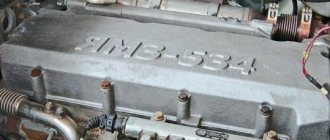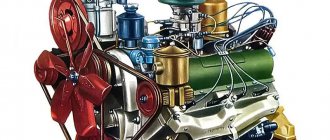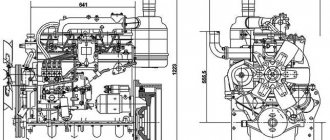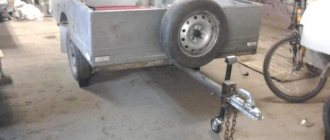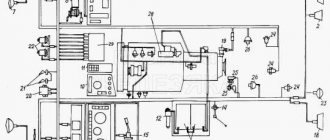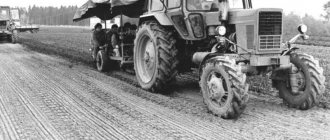Bus MAZ-241. Photo MAZ
MAZ-241 is a Belarusian small-class bus produced by the Minsk Automobile Plant. The MAZ-241 city bus is used for passenger transportation on medium-load routes. The model is intended for intercity and suburban transportation, tourist trips and corporate trips.
Detailed description, device
The model was developed as part of the school bus program . The bus was first introduced in 2011. Serial production began in 2013.
The model is equipped with a large number of electronic security systems . The climate control system performs its functions perfectly regardless of the season. The bus has excellent value for money.
The bus has a visually attractive appearance . Its base has high wear-resistant characteristics . The passenger compartment has a large glass area . The windshield also differs in size. It should be noted that there is a durable load-bearing body and luggage racks.
City/suburban bus MAZ-241. Photo MAZ
According to the standard, the roof of the MAZ-241 has a hatch for complete ventilation . As a rule, the design is made in light colors. If it is for transporting school groups, the car is painted yellow. Also, models in metallic colors and green shades have become widespread.
The exterior design combines clean lines. The paintwork is resistant to rain, snow, etc. The material from which the body is constructed meets quality standards.
When creating the bus, the manufacturer paid the necessary attention to the quality of the interior. , 22 comfortable passenger seats were installed , each provided with an appropriate level of safety. The driver's seat is comfortable, has soft filling, is equipped with seat belts and is adjustable.
It should be noted that there is a large volume of the cabin , the interior of which has an exquisite finish . The MAZ-241 door control is electronic, and there is a high response speed. The car can be equipped with a multimedia system.
The presence of an air conditioning system helps maintain optimal temperature in the cabin. Thanks to the internal lighting system, comfortable conditions are provided for each passenger. The silhouette of the cabin is symmetrically complemented by planted optical elements.
Standard external optics are distinguished by their expressiveness and guarantee the vehicle driver maximum illumination of the road. With the help of side mirrors, it is possible to fully view the situation behind the car. The mirror does not distort the image at all.
The chassis of a vehicle allows the driver to maneuver on the roadway and counteracts roll when turning. On the bus, the manufacturer installed a dependent air suspension with telescopic shock absorbers , which creates optimal conditions for passengers in the cabin. All elements related to the suspension and steering system are of high quality and can last a long time.
Driver's outpost
From a driver's point of view, things are no longer so simple. To begin with, it would not hurt to get into the cockpit. And here the driver encounters the first joke - the driver’s door is missing as a class. The reason for this “dislike” is quite prosaic - a personal entrance on the left side is a labor-intensive and expensive element, and, whatever one may say, it weakens the rigidity of the body. And if in large-scale production it is at least possible to reduce the price of this door, then in small-scale production it is easier to make the left side “blind”. True, in this case, the entrance to the driver’s workplace is made through the cabin, and with the “engine over the front axle” layout used, this is almost always associated with performing spectacular, but in most cases unpleasant acrobatic movements.
Naturally, MAZ would not be MAZ if it had not offered its solution to this problem. The engine was simply moved to the right, and as a result, a convenient wide passage was created on the left between the engine casing and the driver’s seat, which is even accessible by the gear lever, not to mention versions with an automatic transmission. True, on buses with Cummins and Navistar engines, a restless nook of unknown purpose has formed on the right side. But the Minsk MMZ uses this space for its needs, so everything is quite logical.
Once at the workplace, the driver has at his disposal a convenient “captain’s bridge” with a competent arrangement of working parts. The instrument panel is an updated version of the first generation city buses, shown back in 2009, but never reaching the production line. The instrument cluster can be of two types - with fully dial instruments and combined. I will not describe them, everything is visible in the photo, I will only note that the second one is more convenient to use - it is more compact and the top row of dials is not blocked by the steering wheel rim under any circumstances.
But what is absolutely missing are compartments for small items - two shallow niches on the panel and a tiny pocket to the left of the driver look like a mockery against the backdrop of the huge unused areas. We definitely still have to work on this.
Thanks to the large glass area, visibility from the driver's seat is very good. It is spoiled a little by the wide pillars, but not critically. But two simple mirrors, although they cope with their task, look flawed against the backdrop of modern design. And a couple of additional sections that allow you to control the right front corner would not hurt. In addition, taking into account the “blind” window and the complex layout of the right side of the cabin, electrical adjustment of the right mirror simply begs to be done. So far, the process of setting it up causes a lot of negative emotions.
Modifications
The model line of MAZ-241 buses contains various configurations, which are indicated by adding some symbols after the general name of the vehicle.
The bus was equipped with an ISF3.8s engine (Cummins, 177 hp) or MMZ D-245.35E4 (Minsk Motor Plant, 170 hp). Models with an American engine are designated MAZ-241000 (suburban) and 241S00 (school), with a Belarusian engine - MAZ-241030 (suburban) and 241S30 (school).
Bus MAZ-241, school modification. Photo MAZ
MAZ-241030 variation is equipped with a Cummins engine with a power of 170 horsepower, an automatic transmission unit from Fast Gear with a six-speed gearbox.
The bus under the symbol 241S30 is a model for those who value comfort. The designers have provided all the necessary details to make traveling in such a vehicle truly comfortable for both passengers and the driver.
New MAZ-241S30 and MAZ-257 buses and the “School Bus” social program
Andrey Filippov, photo by the author
year 2013. Minsk Automobile has launched a joint social program “School Bus”. Its essence is to transfer MAZ-241 buses to school institutions in Belarus to transport children from remote villages to their places of study. And the highlight of the project was the fact that all the buses were to be driven by... women. The original idea was implemented, and lovely ladies driving school buses became a symbol of safety when transporting children: mothers themselves, they understand the value of their passengers better than anyone else...
Three years have passed since the start of the project. In 2013, 60 buses were delivered, in 2014 – 15 units, in 2015 another 61 “schoolchildren” began to transport small passengers. This year made it possible to exchange the second hundred - we were able to attend the handover of the batch where the 200th copy of the MAZ-241 was located. What has changed over the past years?
"Oldies"...
In principle, there are not so many changes. First of all, electronic accessories were added, for example, a large monitor under the ceiling, on which you can entertain the children with cartoons or films during long trips - the journey from school to home sometimes takes up to an hour. And no one has canceled excursions yet.
Secondly, it is worth noting the rearrangement of the engine shaft, which is associated not only with the installation of a Cummins engine instead of the MMZ, but also with the improvement of its sound insulation, which is an undoubted benefit for the comfort of both the driver and small passengers.
There are also other improvements, but I won’t list them all. Moreover, the modernization process was carried out gradually, and all the changes are striking only in comparison with the very first MAZ-241, delivered to schools in 2013. The main difference between the current batch is new seats with four-point belts. Before this, standard seats from commuter versions of serial buses were installed.
In general, the process is underway.
Basic information, characteristics
Manufacturer/manufacturer where the equipment is produced/manufactured. OJSC Minsk Automobile Plant (MAZ) is a managing Soviet and Belarusian automobile manufacturing company specializing in the production of heavy-duty automobiles, as well as buses, trolleybuses and trailers.
Purpose. City, suburban, tourist, intercity, excursion, school.
Class. Small.
Body type. Carrier.
General information
The bus is equipped with a Cummins ISF3.8 S diesel power unit with four cylinders. The engine meets the requirements of the environmental standard at the Euro-4 level and is equipped with a six-speed manual transmission. Each dependent air suspension with a pair of cylinders has two telescopic shock-absorbing elements.
The MAZ-241 bus is equipped with a brake unit with protection against slipping and blocking. Equipping with individual blower panel devices, fans fixed on the ceiling of the roof and in the hatch of the vehicle helps create the most acceptable climatic conditions.
The objective advantages of the MAZ-241 bus include panoramic glazing, which guarantees excellent visibility, as well as a modernized dashboard and a convenient system for placing luggage compartments. A special closed compartment is equipped for the spare wheel, protected from below. Additionally, the practical roller mechanism makes it easy to remove the spare tire. The bus capacity is 36 people, with 22 seats.
Specifications
Dimensions and layout of the MAZ-241 bus. Photo MAZ
Fuel type. Diesel.
Fuel tank capacity. 190.
Curb and technically permissible weight, kg. 6700 and 9300.
Load on front/rear axle based on technically permissible weight, kg. 5200/4100.
Minimum turning radius, m. 9.
Steering gear. With hydraulic booster.
Steering gear type. Integral.
Brake system. The pneumatic braking system is reliable. It should be noted that there is an anti-slip and anti-lock system. The presence of these systems greatly facilitates control; the speed is quickly slowed down during icy conditions. Disc brakes, which are designed for a long service life, are distinguished by their operating efficiency.
History of creation
The Minsk residents released their first platform bus, the MAZ-171, almost “low-key.” No one produced such equipment in the post-Soviet space, but there was a need for it: airports in large cities were developing, receiving international certificates, and it was necessary to fulfill requirements related to passenger transportation, among other things. So the Minsk Automobile Plant came to the rescue: it came up with a bus from scratch, unlike any other model produced at the enterprise. And the 171st became successful.
Platform bus MAZ-171. Photo RusbusinessAuto
He was always special. The proximity to airplanes probably has an effect. The platform bus is very different from any other model that can be found on the roads. Wide, long, with doors on both sides: 171 has become one of the symbols of the National Airport.
Platform buses at that time were produced only by foreign companies. The Belarusian company had experience in international cooperation: the first Minsk city buses began with a contract signed with the German Neoplan. But the Minsk residents decided to make their own platform bus.
To those who came to the airport in those years, it seemed that this was the bus of the future. Unusually wide, ultra-low-floor, ultra-spacious - it’s clear that it’s not for city streets, but it looked impressive.
For a long time, the 171st was the link between earth and sky: it transported passengers to the plane's ramp and picked up those who returned to the ground. A workhorse, albeit a very futuristic one. Years passed, planes took off and landed, the future gradually took shape into the present.
At the end of 2022, the Minsk Automobile Plant began to work closely on developing a new generation model.
It was decided to stick to the dimensions of the 171st. The main quality of a platform bus is its high passenger capacity, which is why the models are so wide.
An interesting detail: the type of buses at airports will be partly decided by the railway workers. One way or another, equipment has to be transported on railway platforms, and for such cargo there are width restrictions.
Important How to carry out maintenance and install autonomy in KamAZ-43118
Characteristics of the new model:
- length - 14.48 m;
- width - 3.19 m;
- maximum height (including air conditioning) - 3.25 m;
- passenger capacity - up to 112 people.
This bus is significantly larger than any other designed for urban transportation.
Chassis characteristics
Main bridge. The front axle is equipped with a cone-shaped gearbox.
Wheel formula. 4x2.
Wheelbase, mm. 3800.
Wheel track (front/rear), mm. 2110/1908.
Ground clearance/ground clearance, mm. 142.
Clutch type. Friction, single-disc.
Tires. 245/70R19.5.
Wheels. Disc 6.75X19.5.
Anti-lock braking system (ABS). Present.
Other data
MAZ-241, the basic technical characteristics of which are presented above, has the following additional indicators:
- Maximum load supported by front/middle/rear axle (t) – 4.1/5.2/5.3.
- Estimated passenger capacity (sitting/standing) – 22/35 people.
- Front/rear track (m) – 2.1/1.9.
- Ground clearance (cm) – 14.2.
- Motor torque is 1300-1700 rpm.
- Cooling is liquid.
- The presence of turbocharging – yes.
- Power plant volume (cubic cm) – 3760.
- The compression ratio in the combustion chamber is 17.2.
- Engine features - the piston unit is located in-line, runs on diesel fuel, and has an injection system.
Engine/powertrain characteristics
Suburban bus MAZ-241. Photo Wikipedia
Brand. Cummins ISF3.8s / MMZ D-245.35E4.
Type. Diesel.
Number and arrangement of cylinders. 4 and in-line.
Environmental safety standards. Euro-4.
Working volume, l. 3,76 / 4,75.
Engine power, kW (hp)/min. 130 (177) / 125 (170).
Maximum torque, Nm/min. 170 at 2400 rpm. / 580 at 1300–1600 rpm.
Engine location. Front.
Checkpoint. Mechanical Fast Gear 6J70T.
Front-rear axle suspension. Dependent pneumatic 2-balloon with telescopic shock absorbers/ dependent spring pneumatic 2-balloon with 2 telescopic shock absorbers.
Maximum speed, km/h. 107 / 116.
What's worth noting?
The MAZ-241 bus, the photo of which is presented below, has a number of advantages compared to similar models.
This modification is made in a compact design; in addition, an extended version has been developed. The vehicle has a significant glass area in the passenger compartment and a spherical windshield. Visibility, as the owners of this equipment note in their reviews, meets the main purpose of the equipment, namely serving tourist groups when visiting various attractions. The car has an impressive width. The main homofocal optics and rear multi-component light elements harmoniously complement the overall picture.
The entrance door is singular; the driver and passengers enter through it. Whether this is good or bad is difficult to answer unequivocally. The interior of the cabin is decorated in light colors, which creates the impression of spaciousness and comfort.
Comfortable passenger seats are made by the German company Vogel Sitze. The chairs are placed according to the classic version, not counting the first single seat (for the guide or conductor). It is deployed at right angles to the other passengers and faces the driver.
Comparison with closest competitor
If we compare the MAZ-241 and PAZ-320412 buses, we can note that these vehicles have significant differences . The Belarusian model has a soft ride, it has a monocoque body, and the PAZ is simple and reliable, but less comfortable.
In terms of its overall dimensions, the MAZ can be compared with the smallest “Pazov” model. In terms of internal equipment, the presented body version does not yet resemble a long-distance car. In addition, the PAZ suspension has no pneumatic elements. The determining factor in choosing the main competitor for a comparative test drive was the similar interior design . MAZ has a more modern design. This applies to both exterior and interior equipment.
An expressive belt line made of plastic, a panoramic windshield, and specific aquarium-type glazing - all these are successful solutions from the developers , perfectly implemented in the bus in question. At first glance, you get the impression that the car is slightly flattened at the top. A similar effect is achieved due to the proportions of the bus. Its width is 2550 mm, while it has a low-slung load-bearing body element, the height of which is only 2780.
Glass and plastic
Now in the model range there are three types of power plants: the Belarusian-Chinese tandem of MMZ and a Shaanxi manual transmission, the Chinese pair of Cummins and the same Shaanxi gearbox, and the American-Belarusian Navistar with an Allison automatic transmission.
The driving experience of the three cars is very different. This is noticeable both during acceleration and when shifting gears, and, most importantly, in terms of noise – in this parameter the MMZ “leads”, and not in terms of sound volume, but in terms of the strength of vibrations emanating from it. Cummins is much calmer, clearer and now, probably, this is the best option both in terms of perception and in terms of future operation - it’s not for nothing that the vast majority of bus manufacturers actively use engines of this brand. Only the gearbox should still be replaced with something more well-known. But the tandem of the experimental engine jointly produced by Navistar - MTZ and the Allison automatic transmission, it seems, will remain in a single copy. But this is even for the better - the combination turned out to be so-so, especially when driving on our winter roads, which, whatever one may say, averages 3-5 months a year, depending on the region.
Based on general impressions of driving the MAZ-241, it is worth noting that the short wheelbase, despite the presence of stabilizers on both axles, has a rather nimble disposition and on broken roads it seems that the bus is about to jump to the side. In reality, he goes where he needs to and really begins to scour only on potholes dusted with snow, rolled to the icy surface. This can be treated quite simply - we reduce the speed from 80 km/h to 60 km/h, and we again have an obedient and pleasant bus in our hands.
What will certainly please those who will work on the MAZ-241 is its maneuverability. Thanks to the same short wheelbase, the car feels like a fish in water in the city. Finding a parking space is not a problem; turning around on a narrow street is a breeze. At the same time, the low body height allows you not to be afraid of low tree crowns in the city, and when driving outside of it, strong gusts of wind and sharp turns - on normal asphalt the bus “writes a route”, as if on rails. And when driving along our country roads, the main thing is not to fly headlong - within reasonable limits, the air spring suspension allows you to maintain a good pace and acceptable comfort even on a patchy and pothole surface.
Interior equipment
The MAZ-241 small category vehicle is intended for various types of passenger transportation. The car has a length of 6800 mm and is equipped with 22 comfortable seats.
The main ventilation in the cabin is carried out through the hatch, opening windows, and also forcedly using fans. To maintain appropriate microclimatic conditions, a distributed personal ventilation design for passengers has been introduced.
The driver's seat is adjustable in several positions and has memory positions for different drivers. The updated control panel meets the ergonomic and design requirements of our time. The steering column is a sophisticated design that prevents the possibility of injury in an unusual situation.




